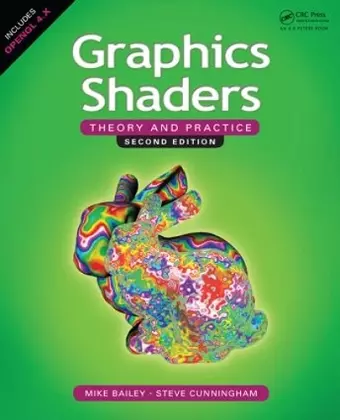Graphics Shaders
Theory and Practice, Second Edition
Steve Cunningham author Mike Bailey author
Format:Hardback
Publisher:Taylor & Francis Inc
Published:8th Nov '11
Currently unavailable, and unfortunately no date known when it will be back

Graphics Shaders: Theory and Practice is intended for a second course in computer graphics at the undergraduate or graduate level, introducing shader programming in general, but focusing on the GLSL shading language. While teaching how to write programmable shaders, the authors also teach and reinforce the fundamentals of computer graphics. The second edition has been updated to incorporate changes in the OpenGL API (OpenGL 4.x and GLSL 4.x0) and also has a chapter on the new tessellation shaders, including many practical examples.
The book starts with a quick review of the graphics pipeline, emphasizing features that are rarely taught in introductory courses, but are immediately exposed in shader work. It then covers shader-specific theory for vertex, tessellation, geometry, and fragment shaders using the GLSL 4.x0 shading language. The text also introduces the freely available glman tool that enables you to develop, test, and tune shaders separately from the applications that will use them. The authors explore how shaders can be used to support a wide variety of applications and present examples of shaders in 3D geometry, scientific visualization, geometry morphing, algorithmic art, and more.
Features of the Second Edition:
- Written using the most recent specification releases (OpenGL 4.x and GLSL 4.x0) including code examples brought up-to-date with the current standard of the GLSL language.
- More examples and more exercises
- A chapter on tessellation shaders
- An expanded Serious Fun chapter with examples that illustrate using shaders to produce fun effects
- A discussion of how to handle the major changes occurring in the OpenGL standard, and some C++ classes to help you manage that transition
The authors thoroughly explain the concepts, use sample code to describe details of the concepts, and then challenge you to extend the examples. They provide sample source code for many of the book’s examples at www.cgeducation.org
"If you are one of the multitudes of OpenGL programmers wondering about how to get started with programmable shaders or what they are good for, this is the book for you. Mike and Steve have filled their new edition with such a variety of interesting examples that you'll be running to your computer to begin writing your own shaders."
—Ed Angel, Chair, Board of Directors, Santa Fe Complex, Founding Director, Art, Research, Technology and Science Laboratory (ARTS Lab), Professor Emeritus of Computer Science, University of New Mexico
"Shaders are an essential tool in today’s computer graphics, from films and games to science and industry. In this excellent book, Bailey and Cunningham not only clearly explain the how and why of shaders, but they provide a wealth of cutting-edge shaders and development tools. If you want to learn about shaders, this is the place to start!"
—Andrew Glassner
Praise for the First Edition:"Bailey and Cunningham provide a comprehensive, well-written overview of graphics shaders. … Although the book uses the OpenGL Shading Language (GLSL) for its examples, it gives enough theoretical background for readers to learn the fundamentals for any graphics language. … The book also addresses scientific visualization and the GLSL API to call GLSL functions from an OpenGL program. A final chapter offers ideas for using shaders in very entertaining ways. … Highly recommended."
—C. Tappert, CHOICE, December 2009
"… a pick for any college-level, advanced computer library catering to programming professionals. … discusses different types of shaders, how to use the glman program for free, and how to blend shaders into an interactive game environment. Libraries will find it a powerful, appealing lend for intermediate programmers seeking extra spice for their projects."
—Midwest Book Review, August 2009
"If you are one of the multitudes of OpenGL programmers wondering about how to get started with programmable shaders or what they are good for, this is the book for you. Mike and Steve have filled their new edition with such a variety of interesting examples that you'll be running to your computer to begin writing your own shaders."
—Ed Angel, Chair, Board of Directors, Santa Fe Complex, Founding Director, Art, Research, Technology and Science Laboratory (ARTS Lab), Professor Emeritus of Computer Science, University of New Mexico
"Shaders are an essential tool in today’s computer graphics, from films and games to science and industry. In this excellent book, Bailey and Cunningham not only clearly explain the how and why of shaders, but they provide a wealth of cutting-edge shaders and development tools. If you want to learn about shaders, this is the place to start!"
—Andrew Glassner
Praise for the First Edition:"Bailey and Cunningham provide a comprehensive, well-written overview of graphics shaders. … Although the book uses the OpenGL Shading Language (GLSL) for its examples, it gives enough theoretical background for readers to learn the fundamentals for any graphics language. … The book also addresses scientific visualization and the GLSL API to call GLSL functions from an OpenGL program. A final chapter offers ideas for using shaders in very entertaining ways. … Highly recommended."
—C. Tappert, CHOICE, December 2009
"… a pick for any college-level, advanced computer library catering to programming professionals. … discusses different types of shaders, how to use the glman program for free, and how to blend shaders into an interactive game environment. Libraries will find it a powerful, appealing lend for intermediate programmers seeking extra spice for their projects."
—Midwest Book Review, August 2009
ISBN: 9781568814346
Dimensions: unknown
Weight: 1020g
492 pages
2nd edition